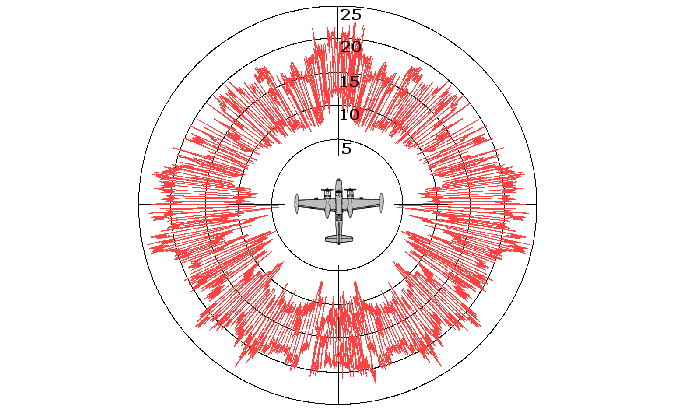The discussion on how effective radar absorbent materials are for wind turbine radar mitigation is often confused due to a lack of clarity on how a standard wind turbine actually affects a radar system.
Radar Cross Section
The apparent “size” of any object to a radar is termed its Radar Cross Section (RCS), which is specified in metres squared or sometimes in decibel metres squared.
 Figure 1: Radar Cross Section (RCS) diagram example of an A-26 Invader
Figure 1: Radar Cross Section (RCS) diagram example of an A-26 Invader
Unfortunately the actual RCS of any object varies massively, depending on the angle you are viewing it from. In one example the difference between the minimum and maximum RCS of a twin engine B26 bomber varies by a factor of about 5,000.
The RCS of a wind turbine blade varies similarly as the wind turbine rotates with the measured radar cross section also varying by a factor of 10,000 during one complete revolution.
When RCS values are cited for an aircraft or when specifying radar performance it is usual to specify some sort of average value which falls somewhere between the minimum and maximum RCS values.
In wind turbine radar interference modelling there are often two factors that can make modelling over-conservative. These are:
- Using the wind turbine blade maximum RCS rather than the average RCS used to specify the radar’s performance
- Determining that the reflected energy from the wind turbine is emitted from the wind turbine tip when it is in fact distributed across the wind turbine
Typically the mean RCS is one tenth of the peak RCS and the median is one hundredth of the peak RCS. Confusing the mean or the median with the peak can therefore lead to significant errors.
Approximate values
Large Wind turbine blades at S-Band have the following RCS values in dB metres squared: Maximum 34, Mean 24, Median 14, Minimum -6
B26 Twin Engine bomber (about 10 tonnes) at S-Band has the following RCS values in db metres squared: Maximum 37, Mean 27, Median 17, Minimum 0
Conclusions
- Wind turbine RCS varies. Aircraft RCS varies too.
- Wind turbine RCS is about the same as aircraft RCS.
Notes
- For aircraft RCS Figure 2.15 in Skolnik’s Introduction to Radar has been used.
- For wind turbine RCS Qinetiq’s measurements in their trial at Swaffham UK have been used.
Image accreditation: Averse at the German language Wikipedia / CC BY-SA 3.0 / Image resized from original.
